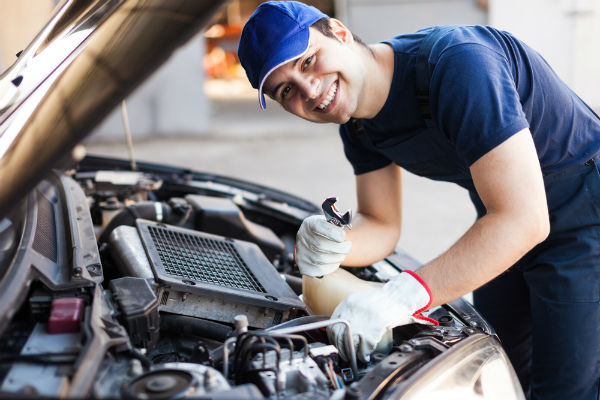10 CAR MAINTENANCE TIPS: DRIVING A CAR MEANS TAKING CARE OF A CAR

Maintaining a car isn’t so hard if you know the basic steps. A properly maintained car runs more efficiently, which means it uses less gas and costs you less money to operate.
We offer some car maintenance tips below, but the first thing you should do is spend some time with your car owner’s manual. Right, we know you don’t need more assigned reading, but your car owner’s manual is worth it.
The owner’s manual lists the mileage intervals at which to change the oil and perform routine service on your vehicle to keep it running well. Your car owner’s manual contains useful information. Don’t ignore it.
No. 1 Car Maintenance Tip: Regular Oil Changes
The easiest and most useful thing you can do to take care of any motor vehicle is change its oil regularly. Most car manufacturers recommend an oil change every 3,000 to 5,000 miles. Use the grade of motor oil your car’s manufacturer recommends. A different grade of motor oil can lower your gas mileage.
If you’re a do-it-yourselfer, learning how to change the oil in your car is an easy way to save money. If you’d rather not, there are plenty of garages that will take care of it for you. Many will even put a sticker on your windshield to remind you of when the next change is due.
If you change your own motor oil, collect and store the used oil in a sturdy plastic container and take it to a recycling center. Dumping oil down storm drains or on the ground can contaminate ground water. Consider using refined oil in your vehicle.
If you get your oil changed at a garage, they’ll probably check your air filter as well. Recommendations about how often you should change your air filter vary. Some experts say every 3,000 miles or with every oil change, while some car manufacturers say you can go as long as 45,000 miles. Your owner’s manual will say, but you should make sure your car has a clean air filter. A dirty air filter can increase your car’s fuel consumption by as much as 10 percent.
Many quick-oil-change garages can take care of a lot of standard maintenance that your car needs. They’ll keep records of what’s been done for your car, and most can tap into your car’s computer to find out what maintenance is due. If you use the same shop regularly, they can keep your car on schedule.
Look for a maintenance shop that displays some kind of certification, like the Automotive Service Excellence (ASE) seal. Certification indicates that some or all of the technicians meet basic standards of knowledge and competence in specific technical areas. Make sure the certifications are current, but remember that certification alone is no guarantee of good or honest work.
Even if you’re a regular at an auto maintenance center, you can protect yourself if you know a little about what your car needs.
Nine More Tips for Keeping Your Car Running Right
- Never ignore the check-engine light. It can alert you to serious problems, even when your vehicle seems to be running fine. If the light comes on, get a maintenance technician or mechanic to take a look. If the check engine light blinks or flashes while the engine is running, your vehicle may have a serious emissions-related problem that needs immediate attention to prevent permanent catalytic converter damage.
- Flush the cooling system and change coolant once a year. A 50/50 mix of coolant and distilled water will keep the cooling system in good shape and prevent corrosion and deposits from building up inside the cooling system.
- Keep tires inflated properly. The proper tire pressure for your car is listed in your owner’s manual or on a sticker that is either in the glove box or driver’s side door jamb. This number may differ from the maximum pressure listed on your tire’s sidewall. If you have a full-size spare tire, don’t forget to keep an eye on its inflation.
- To help equalize wear, rotate and align your tires every 6,000 to 8,000 miles.
- Don’t let worn windshield wipers leave you with no view of the road in a downpour. That poses a safety hazard. If you notice the wipers cause streaks or smears or they skip or scrape along the surface of the glass, replace them. New blades don’t cost much and are quickly installed.
- Every few months, take a minute to check your car’s lighting – headlights (including high beams), tail lights, brake lights, turn signals and interior lights – while your car is parked to make sure everything works. If something is out, get a technician to check to see whether it is a blown bulb or fuse and replace it.
- Inspect batteries, battery cables and the radiator for corrosion, cracks, and dirt on a regular basis. You can wash, vacuum or wipe away built-up dirt and grime. Hot weather can shorten a battery’s life, so have it tested if it is near the end of its warranty.
- If you hear or feel your brakes, have them checked. Brake pads wear away and replacing them is a part of routine car maintenance. If you hear a metallic screeching noise or your car shakes, grinds or pulls to one side when you hit the brakes, you need new brake pads.
- Have the exhaust systemchecked once a year for carbon monoxide leaks, which can be especially dangerous during cold weather driving when windows are closed.
More Information:
